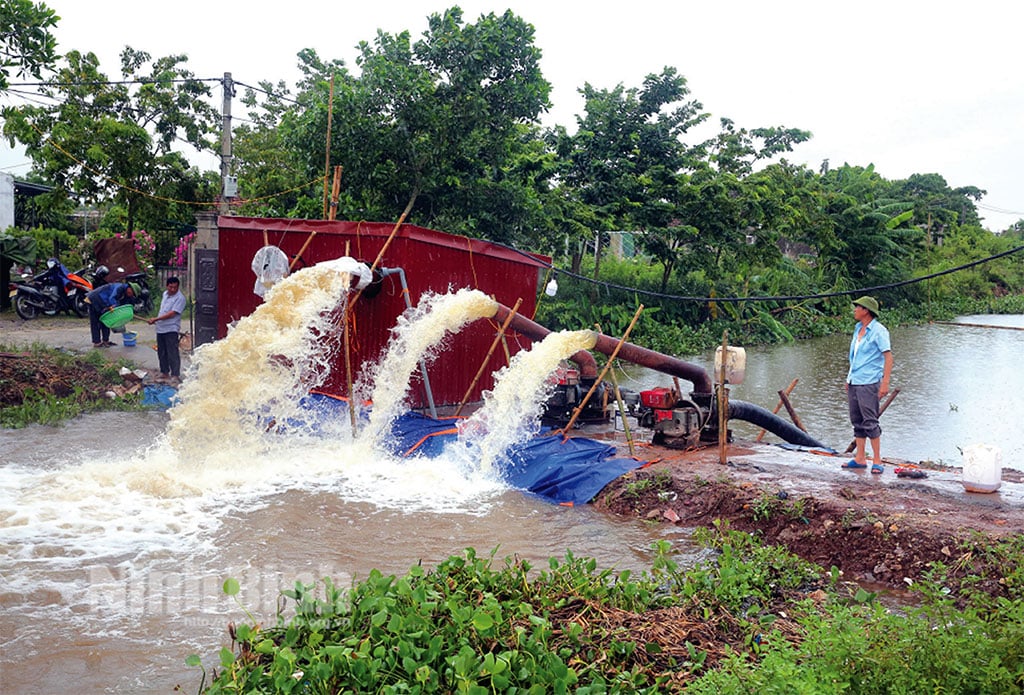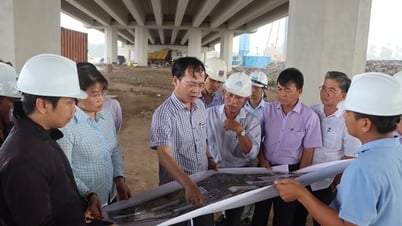Prolonged heavy rains in recent days have flooded more than 10,000 hectares of newly planted rice in the province, putting them at risk of total loss. To proactively drain water and protect production, units and localities are urgently implementing many solutions to overcome the flooding situation.

A field pumping station was installed to drain water for the area of An Hoa and Hung Tien communes (Kim Son). Photo: Anh Tuan
Many newly planted rice areas were damaged.
Due to the influence of the northern edge of the tropical convergence zone with its axis through the Central Central region connecting with the tropical depression in the central East Sea area with a tendency to gradually lift its axis to the North, combined with strong high-altitude wind convergence, Ninh Binh province has moderate rain, heavy rain and scattered thunderstorms.
Rainfall from 7:00 p.m. on July 13, 2024 to 7:00 a.m. on July 17, 2024 was generally over 200 mm, the highest in Ninh Binh city at 313.2 mm, the lowest at Nho Quan Meteorological Station at 139.7 mm. Heavy rain occurred right at the time when farmers in the province were focusing on planting the Summer-Autumn rice crop, significantly affecting production.
At Thuong Kiem Cooperative (Thuong Kiem Commune, Kim Son District), basically 250 hectares of newly planted rice were flooded. Ms. Phan Thi Minh, Hamlet 6, Thuong Kiem Commune sadly said: This crop, my family planted 1 acre of rice. Just 3 days after planting, it rained heavily and flooded everything. More than 100 kg of rice seeds, nearly 3 million VND for hiring labor to plant, not to mention the cost of collecting mud, sowing rice, fertilizer, plowing and harrowing, are all lost. I don't know if it can be saved, but today I put the rice seeds out to soak and incubate, and sow rice again to be sure.
According to the report of the People's Committee of Kim Son district, by the end of July 16, the whole district had planted 2,081 hectares of Summer-Autumn rice (equal to 26% of the planned area). Of which, the area of planted rice was 1,788 hectares, the area of sown rice was 293 hectares. However, from July 14 to 7:00 a.m. on July 17, the district continuously had moderate and heavy rain, with a total measured rainfall of over 200 mm. Prolonged heavy rain combined with high water levels on rivers flooded the entire newly planted rice area.
Not only in Kim Son district, in Hoa Lu district, Mr. Pham Thai Thach, Head of the district's Department of Agriculture and Rural Development, said: Recently, the whole district has planted 1,634/2,360 hectares of Summer-Autumn rice, of which the direct sowing area accounts for nearly 70%. These are areas that are very susceptible to flooding, especially in deep-lying fields where drainage is not proactive. Therefore, when there is heavy rain over a large area, nearly 1,000 hectares are flooded, the risk of rice dying, affecting the density, and having to replant is very high.
According to a quick summary from the Department of Agriculture and Rural Development from districts and cities, as of July 17, the whole province has planted 23,344.1 hectares of Summer-Autumn rice (75.2% of the planned area). The flooded area is about 10,293 hectares, mainly concentrated in Yen Khanh, Kim Son, Gia Vien, and Hoa Lu districts.
Urgently overcome and ensure completion of planting in July
Faced with heavy rain threatening production, in recent days, localities and the Provincial Irrigation Works Exploitation One Member Co., Ltd. have actively implemented many measures to drain water and save newly planted rice.
At Bach Cu pumping station, which is responsible for draining water for agricultural production in a large area including Ninh Khang, Ninh My, Ninh Giang communes (Hoa Lu district) and Ninh Khanh, Dong Thanh wards (Ninh Binh city), all 12/12 pumps are operating at full capacity. Mr. Dinh Khanh Chieu, Station Manager of Bach Cu pumping station said: The station arranges 100% of its staff to perform the task, taking turns to continuously check and monitor the voltage and heat dissipation of the pump motor; remove duckweed, trash, and obstacles in front of the screen doors to prevent blockage, ensuring the pumps operate safely, effectively, and drain water to the maximum.
According to information from the provincial Irrigation Department, in recent days, nearly 100% of pumps at all pumping stations in the province have been operating at maximum capacity; at the same time, based on water levels and tides, sluices under the dikes have been opened to drain water as quickly as possible and save the rice. Many rice fields have been safely protected so far.
To proactively respond to and overcome the consequences caused by heavy rains, the Department of Agriculture and Rural Development promptly issued documents directing and guiding its affiliated units and localities. Accordingly, it is requested that the People's Committees of districts and cities direct specialized departments and units, People's Committees of communes, wards and towns, agricultural cooperatives and households mobilize machinery and equipment to clear the flow; organize the operation of irrigation works to drain water, prevent flooding and waterlogging for flooded crop areas. Review the area of Autumn rice, especially the area of sown rice and newly planted rice to assess the ability to withstand flooding, the ability to recover and implement remedial measures after heavy rains. Continue to direct the implementation of the Autumn crop production within the permitted time frame.
For aquaculture areas, direct inspection and reinforcement of pond banks and culverts, check pond water quality, prepare timely treatment plans, and minimize damage caused by heavy rain.
The Irrigation Sub-Department monitors the development of heavy rains, strengthens inspections of works, and coordinates with the Provincial Irrigation Works Exploitation Company to mobilize resources and means to operate works to respond to heavy rains to protect agricultural production. Implement plans to ensure the safety of irrigation works, paying special attention to reservoirs.
The provincial Department of Crop Production and Plant Protection; the provincial Agricultural Extension Center shall increase staff to go to the grassroots level, promptly inform and report on arising situations for handling. Coordinate with localities to guide technical measures to overcome and restore agricultural production due to the impact of heavy rain. Focus on caring for and preventing pests and diseases for rice and vegetable areas not affected by heavy rain. For areas that have been recovered after heavy rain, proceed to destroy golden apple snails, supplement pruning, and take care of recovery. For flooded areas that cannot be recovered, instruct people to proactively use short-term varieties such as Khang Dan 18, Bac Thom No. 7, QR1... to replant. For areas that have not been planted: Drain water, focus on soil preparation, speed up the planting progress, strive to complete planting in July 2024.
Nguyen Luu
Source: https://baoninhbinh.org.vn/khan-truong-khac-phuc-hau-qua-mua-ung-bao-ve-san-xuat-nong/d202407190836154.htm






![[Photo] Prime Minister Pham Minh Chinh and Prime Minister of the Kingdom of Thailand Paetongtarn Shinawatra attend the Vietnam-Thailand Business Forum 2025](https://vphoto.vietnam.vn/thumb/1200x675/vietnam/resource/IMAGE/2025/5/16/1cdfce54d25c48a68ae6fb9204f2171a)



























![[Photo] President Luong Cuong receives Prime Minister of the Kingdom of Thailand Paetongtarn Shinawatra](https://vphoto.vietnam.vn/thumb/1200x675/vietnam/resource/IMAGE/2025/5/16/52c73b27198a4e12bd6a903d1c218846)































































Comment (0)